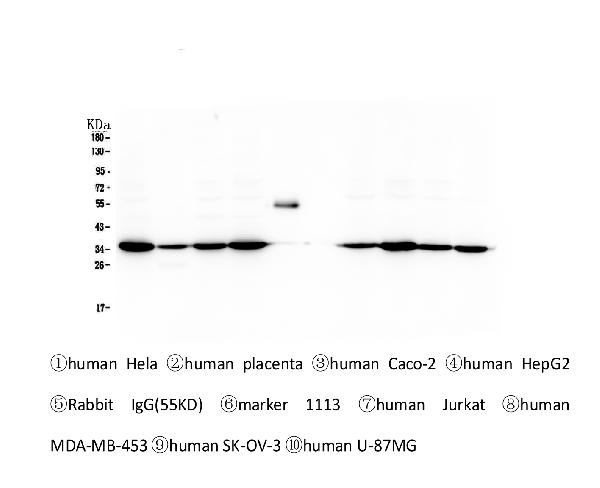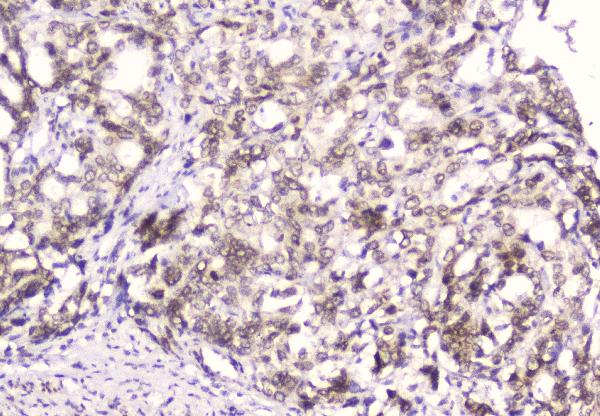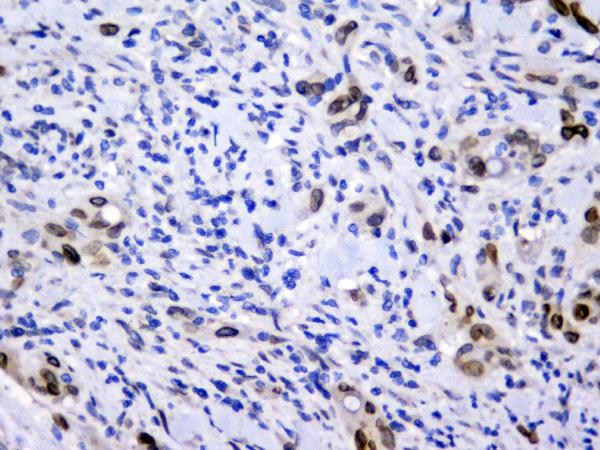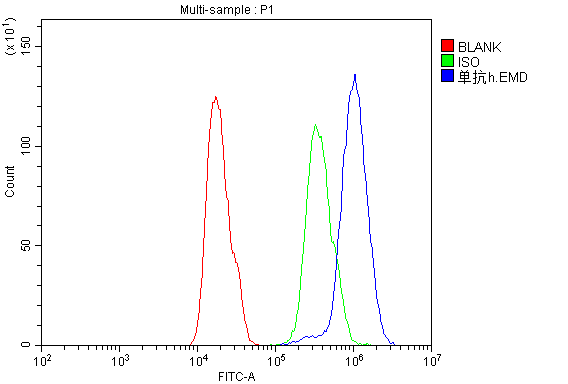Product Info Summary
| SKU: | M00714 |
|---|---|
| Size: | 100 μg/vial |
| Reactive Species: | Human |
| Host: | Mouse |
| Application: | Flow Cytometry, IHC, ICC, WB |
Customers Who Bought This Also Bought
Product info
Product Name
Anti-Emerin EMD Antibody Picoband® (monoclonal, 5A10)
SKU/Catalog Number
M00714
Size
100 μg/vial
Form
Lyophilized
Description
Boster Bio Anti-Emerin EMD Antibody Picoband® (monoclonal, 5A10) catalog # M00714. Tested in Flow Cytometry, IHC, ICC, WB applications. This antibody reacts with Human. The brand Picoband indicates this is a premium antibody that guarantees superior quality, high affinity, and strong signals with minimal background in Western blot applications. Only our best-performing antibodies are designated as Picoband, ensuring unmatched performance.
Storage & Handling
Store at -20˚C for one year from date of receipt. After reconstitution, at 4˚C for one month. It can also be aliquotted and stored frozen at -20˚C for six months. Avoid repeated freeze-thaw cycles.
Cite This Product
Anti-Emerin EMD Antibody Picoband® (monoclonal, 5A10) (Boster Biological Technology, Pleasanton CA, USA, Catalog # M00714)
Host
Mouse
Contents
Each vial contains 4mg Trehalose, 0.9mg NaCl, 0.2mg Na2HPO4, 0.05mg NaN3.
Clonality
Monoclonal
Clone Number
5A10
Isotype
Mouse IgG1
Immunogen
A synthetic peptide corresponding to a sequence at the N-terminus of human Emerin, different from the related mouse sequence by eight amino acids, and from the related rat sequence by nine amino acids.
*Blocking peptide can be purchased. Costs vary based on immunogen length. Contact us for pricing.
Cross-reactivity
No cross-reactivity with other proteins.
Reactive Species
M00714 is reactive to EMD in Human
Reconstitution
Add 0.2ml of distilled water will yield a concentration of 500ug/ml.
Observed Molecular Weight
34 kDa
Calculated molecular weight
28.994kDa
Background of Emerin
APOBEC3G (apolipoprotein B mRNA editing enzyme, catalytic polypeptide-like 3G) is a human enzyme encoded by the APOBEC3G gene. This gene is a member of the cytidine deaminase gene family. It is one of seven related genes or pseudogenes found in a cluster, thought to result from gene duplication, on chromosome 22. Members of the cluster encode proteins that are structurally and functionally related to the C to U RNA-editing cytidine deaminase APOBEC1. It is thought that the proteins may be RNA editing enzymes and have roles in growth or cell cycle control. The protein encoded by this gene has been found to be a specific inhibitor of human immunodeficiency virus-1 (HIV-1) infectivity.
Antibody Validation
Boster validates all antibodies on WB, IHC, ICC, Immunofluorescence, and ELISA with known positive control and negative samples to ensure specificity and high affinity, including thorough antibody incubations.
Application & Images
Applications
M00714 is guaranteed for Flow Cytometry, IHC, ICC, WB Boster Guarantee
Assay Dilutions Recommendation
The recommendations below provide a starting point for assay optimization. The actual working concentration varies and should be decided by the user.
Western blot, 0.1-0.5μg/ml
Immunohistochemistry (Paraffin-embedded Section), 0.5-1μg/ml
Immunohistochemistry (Frozen Section), 0.5-1μg/ml
Immunocytochemistry, 0.5-1μg/ml
Flow Cytometry (Fixed), 1-3μg/1x106 cells
Positive Control
WB: human Hela whole cell, human placenta tissue, human Caco-2 whole cell, human HepG2 whole cell, Rabbit IgG, Marker 1113, human Jurkat whole cellhuman MDA-MB-453 whole cell, human SK-OV-3 whole cell, human SW620 whole cell
IHC: human gastric cancer tissue, human rectal cancer tissue
FCM: A431 cell
Validation Images & Assay Conditions

Click image to see more details
Figure 1. Western blot analysis of Emerin using anti-Emerin antibody (M00714).
Electrophoresis was performed on a 5-20% SDS-PAGE gel at 70V (Stacking gel) / 90V (Resolving gel) for 2-3 hours. The sample well of each lane was loaded with 50ug of sample under reducing conditions.
Lane 1: human Hela whole cell lysates,
Lane 2: human placenta tissue lysates,
Lane 3: human Caco-2 whole cell lysates,
Lane 4: human HepG2 whole cell lysates,
Lane 5: Rabbit IgG,
Lane 6: Marker 1113,
Lane 7: human Jurkat whole cell lysates.
Lane 8: human MDA-MB-453 whole cell lysates,
Lane 9: human SK-OV-3 whole cell lysates,
Lane 10: human SW620 whole cell lysates.
After Electrophoresis, proteins were transferred to a Nitrocellulose membrane at 150mA for 50-90 minutes. Blocked the membrane with 5% Non-fat Milk/ TBS for 1.5 hour at RT. The membrane was incubated with mouse anti-Emerin antigen affinity purified monoclonal antibody (Catalog # M00714) at 0.5 μg/mL overnight at 4°C, then washed with TBS-0.1%Tween 3 times with 5 minutes each and probed with a goat anti-mouse IgG-HRP secondary antibody at a dilution of 1:10000 for 1.5 hour at RT. The signal is developed using an Enhanced Chemiluminescent detection (ECL) kit (Catalog # EK1001) with Tanon 5200 system.

Click image to see more details
Figure 2. IHC analysis of Emerin using anti-Emerin antibody (M00714).
Emerin was detected in paraffin-embedded section of human gastric cancer tissue. Heat mediated antigen retrieval was performed in citrate buffer (pH6, epitope retrieval solution) for 20 mins. The tissue section was blocked with 10% goat serum. The tissue section was then incubated with 2μg/ml mouse anti-Emerin Antibody (M00714) overnight at 4°C. Biotinylated goat anti-mouse IgG was used as secondary antibody and incubated for 30 minutes at 37°C. The tissue section was developed using Strepavidin-Biotin-Complex (SABC)(Catalog # SA1021) with DAB as the chromogen.

Click image to see more details
Figure 3. IHC analysis of Emerin using anti-Emerin antibody (M00714).
Emerin was detected in paraffin-embedded section of human rectal cancer tissue. Heat mediated antigen retrieval was performed in citrate buffer (pH6, epitope retrieval solution) for 20 mins. The tissue section was blocked with 10% goat serum. The tissue section was then incubated with 2μg/ml mouse anti-Emerin Antibody (M00714) overnight at 4°C. Biotinylated goat anti-mouse IgG was used as secondary antibody and incubated for 30 minutes at 37°C. The tissue section was developed using Strepavidin-Biotin-Complex (SABC)(Catalog # SA1021) with DAB as the chromogen.

Click image to see more details
Figure 4. Flow Cytometry analysis of A431 cells using anti-Emerin antibody (M00714).
Overlay histogram showing A431 cells stained with M00714 (Blue line). To facilitate intracellular staining, cells were fixed with 4% paraformaldehyde and permeabilized with permeabilization buffer. The cells were blocked with 10% normal goat serum. And then incubated with mouse anti-Emerin Antibody (M00714,1μg/1x106 cells) for 30 min at 20°C. DyLight®488 conjugated goat anti-mouse IgG (BA1126, 5-10μg/1x106 cells) was used as secondary antibody for 30 minutes at 20°C. Isotype control antibody (Green line) was mouse IgG (1μg/1x106) used under the same conditions. Unlabelled sample (Red line) was also used as a control.
Protein Target Info & Infographic
Gene/Protein Information For EMD (Source: Uniprot.org, NCBI)
Gene Name
EMD
Full Name
Emerin
Weight
28.994kDa
Alternative Names
Emerin; EMD; EDMD; STA EMD EDMD, LEMD5, STA emerin emerin|LEM domain containing 5
*If product is indicated to react with multiple species, protein info is based on the gene entry specified above in "Species".For more info on EMD, check out the EMD Infographic

We have 30,000+ of these available, one for each gene! Check them out.
In this infographic, you will see the following information for EMD: database IDs, superfamily, protein function, synonyms, molecular weight, chromosomal locations, tissues of expression, subcellular locations, post-translational modifications, and related diseases, research areas & pathways. If you want to see more information included, or would like to contribute to it and be acknowledged, please contact [email protected].
Specific Publications For Anti-Emerin EMD Antibody Picoband® (monoclonal, 5A10) (M00714)
Hello CJ!
No publications found for M00714
*Do you have publications using this product? Share with us and receive a reward. Ask us for more details.
Recommended Resources
Here are featured tools and databases that you might find useful.
- Boster's Pathways Library
- Protein Databases
- Bioscience Research Protocol Resources
- Data Processing & Analysis Software
- Photo Editing Software
- Scientific Literature Resources
- Research Paper Management Tools
- Molecular Biology Software
- Primer Design Tools
- Bioinformatics Tools
- Phylogenetic Tree Analysis
Customer Reviews
Have you used Anti-Emerin EMD Antibody Picoband® (monoclonal, 5A10)?
Submit a review and receive an Amazon gift card.
- $30 for a review with an image
0 Reviews For Anti-Emerin EMD Antibody Picoband® (monoclonal, 5A10)
Customer Q&As
Have a question?
Find answers in Q&As, reviews.
Can't find your answer?
Submit your question
5 Customer Q&As for Anti-Emerin EMD Antibody Picoband® (monoclonal, 5A10)
Question
My team were well pleased with the WB result of your anti-Emerin antibody (monoclonal, 5A10). However we have observed positive staining in leukemic t-cell nucleus inner membrane using this antibody. Is that expected? Could you tell me where is EMD supposed to be expressed?
V. Zhao
Verified customer
Asked: 2019-09-10
Answer
According to literature, leukemic t-cell does express EMD. Generally EMD expresses in nucleus inner membrane. Regarding which tissues have EMD expression, here are a few articles citing expression in various tissues:
Cervix carcinoma, Pubmed ID: 17081983, 18220336, 18669648, 18691976, 20068231
Cervix carcinoma, and Embryonic kidney, Pubmed ID: 9673989
Cervix carcinoma, and Erythroleukemia, Pubmed ID: 23186163
Leukemic T-cell, Pubmed ID: 15144186, 19690332
Liver, Pubmed ID: 24275569
Placenta, Pubmed ID: 15489334
Platelet, Pubmed ID: 12665801
Teratocarcinoma, Pubmed ID: 7894480
Boster Scientific Support
Answered: 2019-09-10
Question
We are interested in using your anti-Emerin antibody (monoclonal, 5A10) for negative regulation of fibroblast proliferation studies. Has this antibody been tested with western blotting on hepg2 whole cell lysates? We would like to see some validation images before ordering.
Verified Customer
Verified customer
Asked: 2018-10-01
Answer
We appreciate your inquiry. This M00714 anti-Emerin antibody (monoclonal, 5A10) is tested on human placenta tissue, hela whole cell lysates, hepg2 whole cell lysates, marker 1113, jurkat whole cell lysates, sw620 whole cell lysates, gastric cancer tissue, rectal cancer tissue, a431 cells. It is guaranteed to work for Flow Cytometry, IHC, ICC, WB in human. Our Boster guarantee will cover your intended experiment even if the sample type has not been be directly tested.
Boster Scientific Support
Answered: 2018-10-01
Question
We ordered your anti-Emerin antibody (monoclonal, 5A10) for Flow Cytometry on cervix carcinoma embryonic kidney in the past. I am using human, and We are going to use the antibody for IHC next. I am looking for examining cervix carcinoma embryonic kidney as well as placenta in our next experiment. Could you please give me some suggestion on which antibody would work the best for IHC?
J. Collins
Verified customer
Asked: 2017-10-13
Answer
I looked at the website and datasheets of our anti-Emerin antibody (monoclonal, 5A10) and it seems that M00714 has been tested on human in both Flow Cytometry and IHC. Thus M00714 should work for your application. Our Boster satisfaction guarantee will cover this product for IHC in human even if the specific tissue type has not been validated. We do have a comprehensive range of products for IHC detection and you can check out our website bosterbio.com to find out more information about them.
Boster Scientific Support
Answered: 2017-10-13
Question
We are currently using anti-Emerin antibody (monoclonal, 5A10) M00714 for human tissue, and we are satisfied with the ICC results. The species of reactivity given in the datasheet says human. Is it likely that the antibody can work on monkey tissues as well?
R. Evans
Verified customer
Asked: 2014-06-23
Answer
The anti-Emerin antibody (monoclonal, 5A10) (M00714) has not been validated for cross reactivity specifically with monkey tissues, though there is a good chance of cross reactivity. We have an innovator award program that if you test this antibody and show it works in monkey you can get your next antibody for free. Please contact me if I can help you with anything.
Boster Scientific Support
Answered: 2014-06-23
Question
We have been able to see staining in human cervix carcinoma erythroleukemia. Do you have any suggestions? Is anti-Emerin antibody (monoclonal, 5A10) supposed to stain cervix carcinoma erythroleukemia positively?
M. Mitchell
Verified customer
Asked: 2013-10-29
Answer
Based on literature cervix carcinoma erythroleukemia does express EMD. Based on Uniprot.org, EMD is expressed in esophagogastric junction muscularis propria, teratocarcinoma, placenta, platelet, cervix carcinoma embryonic kidney, leukemic t-cell, cervix carcinoma, cervix carcinoma erythroleukemia, liver, among other tissues. Regarding which tissues have EMD expression, here are a few articles citing expression in various tissues:
Cervix carcinoma, Pubmed ID: 17081983, 18220336, 18669648, 18691976, 20068231
Cervix carcinoma, and Embryonic kidney, Pubmed ID: 9673989
Cervix carcinoma, and Erythroleukemia, Pubmed ID: 23186163
Leukemic T-cell, Pubmed ID: 15144186, 19690332
Liver, Pubmed ID: 24275569
Placenta, Pubmed ID: 15489334
Platelet, Pubmed ID: 12665801
Teratocarcinoma, Pubmed ID: 7894480
Boster Scientific Support
Answered: 2013-10-29





